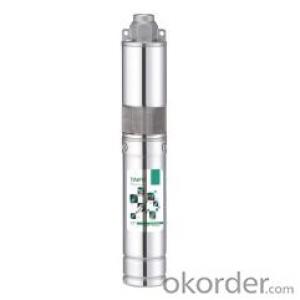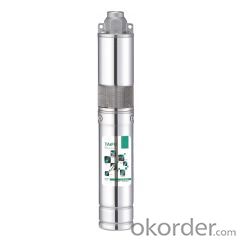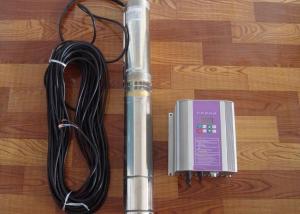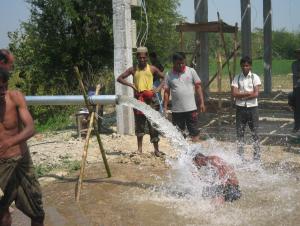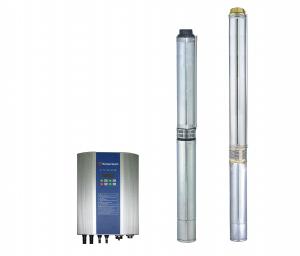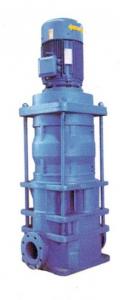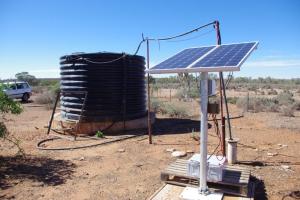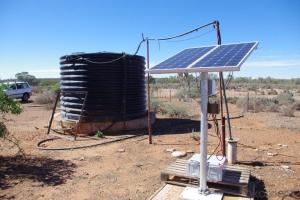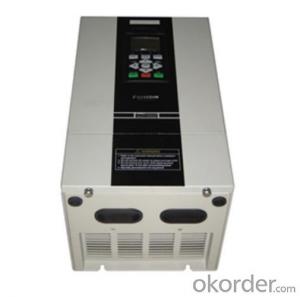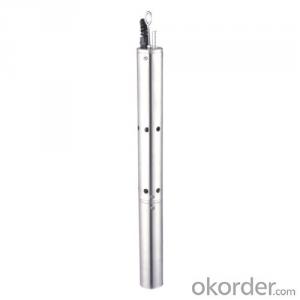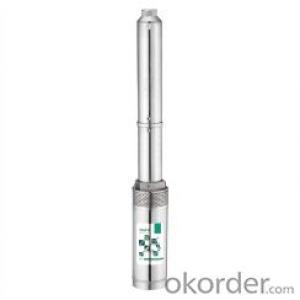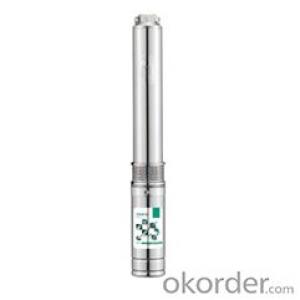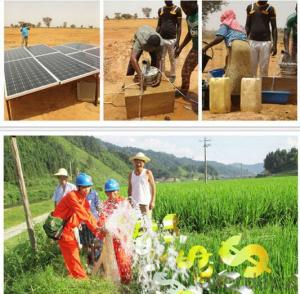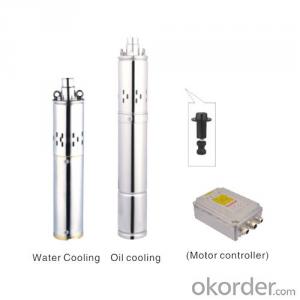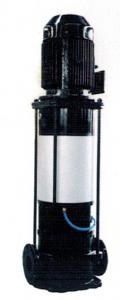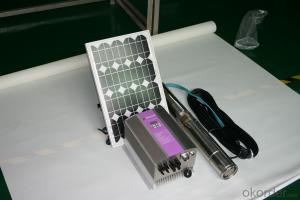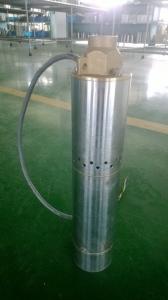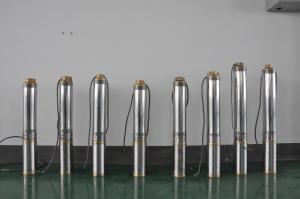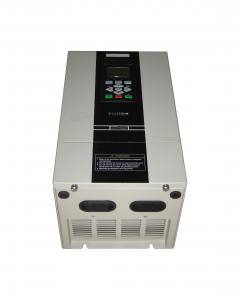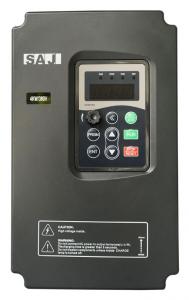Aquascape Solar Pump 3tss/4tss Stainless Steel CE Solar Panel
- Loading Port:
- Shanghai
- Payment Terms:
- TT OR LC
- Min Order Qty:
- 50 pc
- Supply Capability:
- 100000 pc/month
OKorder Service Pledge
OKorder Financial Service
You Might Also Like
1.APPLICATION AREA:This project products are mainly used in dry region for irrigation of agriculture, It can be used for drinking water and
living water. The living condition could be much improved. It also can be used for fountains.2.MATERIAL OF PARTS:Outlet: stainless steel
Pump body: stainless steel
Motor body: stainless steel
Bearing: C&U
3.ADVANCED TECHNOLOGY:1.Application innovation
Compared with the traditional alternating current machine, the efficiency is improved 25% by the permanent magnetism, direct current, brushless, non-sensor motor.
2.Technics innovation
Adopt double plastic package for rotor and stator, motor insulation≥300MΩ, the motor security was much improved.
3.Structure innovation
Oil filling, convenient installation and environmental protection4.HIGHLIGHTSa.Energy-saving and environment-protected green products
b.High technique products adopting MPPT and DSP chip technique.
c.100% copper wire, cold-rolled silicon steel sheet
d.CE certificate
e.Advanced three phase brushless DC motor
f.Stainless steel 316 screws
g.3 years warranty5.PRINCIPLE OF OPERATION:Solar panel collects sunlight→DC electricity energy → solar controller(rectification,stabilization,amplification,filtering)→available DC electricity→(charge the batteries)→pumping water6.ADVANTAGES OF SOLAR PUMP SYSTEM:A.It is easier and more widely used than any other dynamoelectric driven pumps.
B.It is more economical and more environmentally friendly.7.MODEL SELECTION:a.The power of solar panel = power of pump ×1.3
The voltage of solar panel = the voltage of pump
The controller should be matched
b.Select the batteries according to the following formulas:
The use hour of battery =
The battery capacity ÷(the machine power÷the battery voltage)×0.6 For example,the machine power is 200W, the battery
capacity is 100AH,the voltage is 12V,and the battery is fully charged,then the use hour is:100÷(200÷12)×0.6=3.6hours
c.The battery capacity=
the use hour ÷0.6×(the machine power÷the battery voltage) For example,the machine power is 200W,the battery voltage
is 12V,and the battery need to be used for 3.6hours,then the battery capacity is:3.6÷0.6×(200÷12)=100AH

- Q: What is the maintenance cost of a solar pump?
- The maintenance cost of a solar pump varies depending on several factors such as the type and size of the pump, the quality of components used, and the operating conditions. However, in general, solar pumps are known for their low maintenance requirements compared to traditional fuel-powered pumps. Some common maintenance tasks for a solar pump may include regular cleaning of the solar panels to ensure maximum sunlight absorption, inspecting and tightening electrical connections, checking and replacing worn-out parts such as bearings or seals, and monitoring the battery bank if the system includes energy storage. The frequency and cost of these maintenance activities can vary. On average, the annual maintenance cost for a solar pump can range from 1% to 3% of the initial investment cost. However, it's important to note that this is a rough estimate and can vary based on the specific circumstances. Furthermore, it's worth mentioning that the durability and reliability of the components used in the solar pump play a significant role in determining the maintenance needs and costs. Investing in high-quality equipment and reputable brands can help reduce the frequency and cost of maintenance. Overall, while there are maintenance costs associated with solar pumps, they tend to be lower compared to conventional pumps since solar pumps have fewer mechanical parts, require less frequent maintenance visits, and do not rely on expensive fuels.
- Q: Can a solar pump be used in areas with high salinity or mineral content in water?
- Yes, a solar pump can be used in areas with high salinity or mineral content in water. Solar pumps are designed to handle a wide range of water qualities, including those with high salinity or mineral content. However, it is important to consider the specific requirements and limitations of the solar pump being used, as some models may have limitations on the maximum salinity or mineral content they can handle effectively.
- Q: Can a solar pump be used for water supply in national parks or wildlife reserves?
- Yes, a solar pump can be used for water supply in national parks or wildlife reserves. Solar pumps are an environmentally friendly and sustainable option that can provide a reliable and efficient water supply without relying on electricity grids or fuel-powered generators. They can help maintain water sources for animals, vegetation, and visitors while reducing the carbon footprint and minimizing disruption to the natural ecosystem.
- Q: Can a solar pump be used for water supply in recreational facilities or parks?
- Yes, a solar pump can definitely be used for water supply in recreational facilities or parks. Solar pumps are an eco-friendly and sustainable solution that utilize solar energy to power the pump, making them ideal for outdoor spaces like parks or recreational facilities. These pumps can efficiently draw water from natural sources such as lakes, ponds, or wells, providing a reliable water supply for activities like irrigation, fountains, or even for drinking purposes. Additionally, their low maintenance requirements and ability to operate off-grid make them a cost-effective and practical choice for such establishments.
- Q: How long does it take for a solar pump to pay for itself in terms of energy savings?
- The payback period for a solar pump varies depending on factors such as the initial cost, energy savings, and local conditions. Generally, it takes around 2 to 5 years for a solar pump to pay for itself through energy savings.
- Q: Can solar pumps be used for livestock watering?
- Yes, solar pumps can be used for livestock watering. Solar-powered pumps offer a sustainable and efficient solution for providing water to livestock in remote areas or off-grid locations. These pumps utilize solar energy to power the pumping mechanism, eliminating the need for electricity or fuel. They are cost-effective, environmentally friendly, and can provide a reliable water source for livestock, ensuring their hydration and overall well-being.
- Q: Can a solar pump be used for drinking water supply?
- Yes, a solar pump can be used for drinking water supply. Solar pumps are specifically designed to run on solar energy, making them an eco-friendly and cost-effective option for water supply. These pumps use solar panels to convert sunlight into electrical energy, which is then used to power the pump and extract water from a well or other water source. The water can be stored in a tank or directly supplied for drinking purposes. Solar pumps are commonly used in remote areas where access to electricity is limited, providing a reliable and sustainable solution for drinking water supply.
- Q: What is the maximum water depth that a solar pump can reach?
- The maximum water depth that a solar pump can reach depends on various factors such as the type and capacity of the pump, the power of the solar panels, and the efficiency of the system. Generally, solar pumps can reach depths of up to 100 meters or more, but it is best to consult the manufacturer's specifications for accurate information.
- Q: Can solar pumps be used for hydroponic farming or greenhouse irrigation?
- Yes, solar pumps can indeed be used for hydroponic farming or greenhouse irrigation. Solar pumps are an efficient and environmentally friendly alternative to traditional electric or fuel-powered pumps. They harness solar energy to power water circulation systems, making them well-suited for applications like hydroponics or greenhouse irrigation, where a continuous water supply is crucial for plant growth. Solar pumps can provide a reliable and sustainable solution for water management in these agricultural practices.
- Q: How does a solar pump handle water quality issues?
- A solar pump does not directly handle water quality issues. However, it can indirectly contribute to improving water quality by providing a reliable source of clean water. By pumping water from a well or other water source, a solar pump helps reduce the reliance on contaminated surface water, which may contain pollutants or pathogens. Therefore, while the solar pump itself does not address water quality issues, it plays a crucial role in accessing and utilizing cleaner water sources.
Send your message to us
Aquascape Solar Pump 3tss/4tss Stainless Steel CE Solar Panel
- Loading Port:
- Shanghai
- Payment Terms:
- TT OR LC
- Min Order Qty:
- 50 pc
- Supply Capability:
- 100000 pc/month
OKorder Service Pledge
OKorder Financial Service
Similar products
Hot products
Hot Searches
Related keywords
